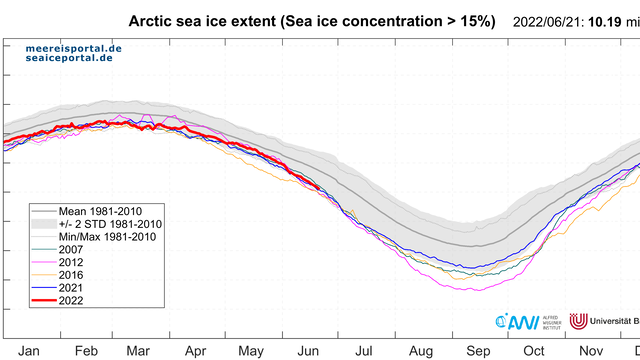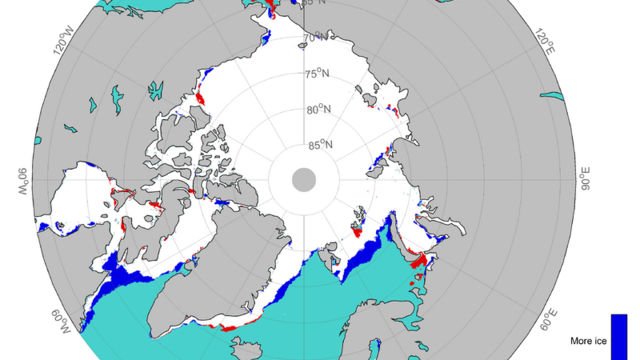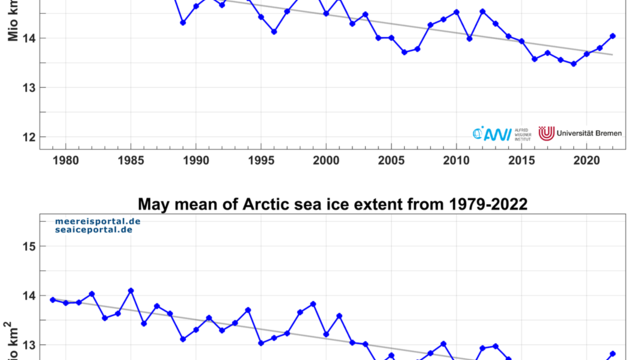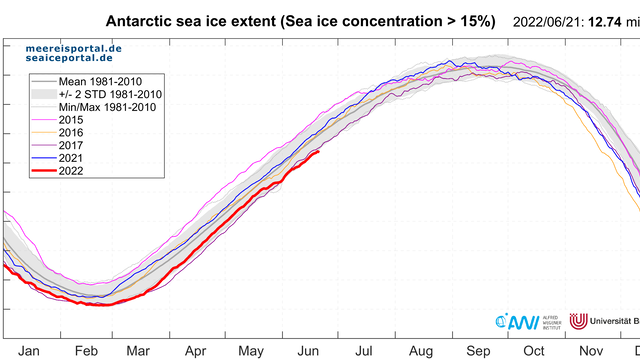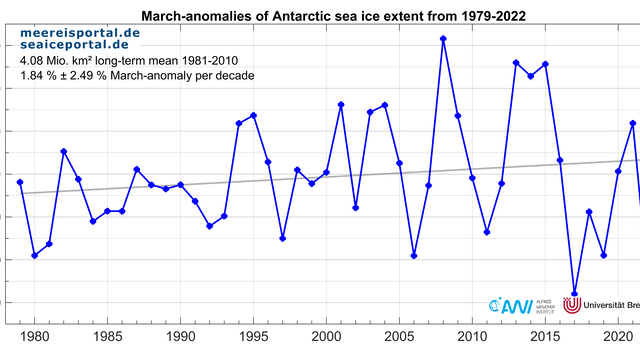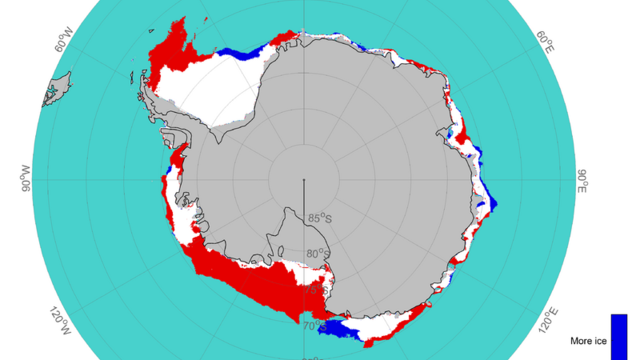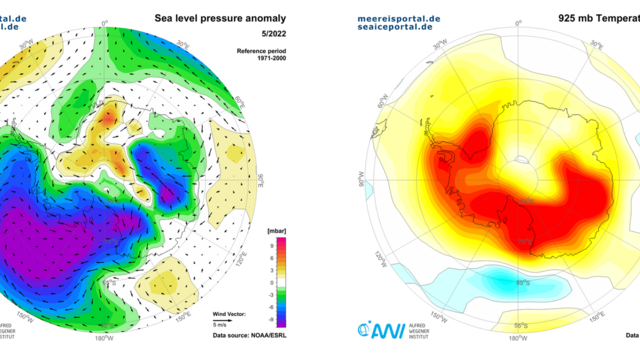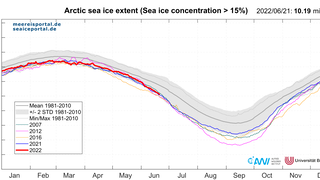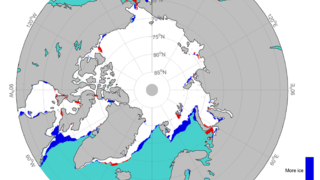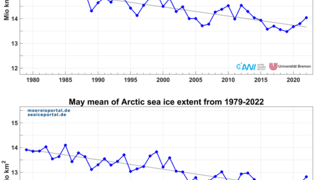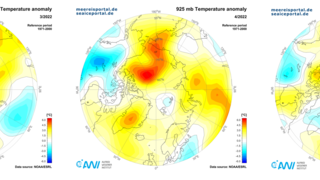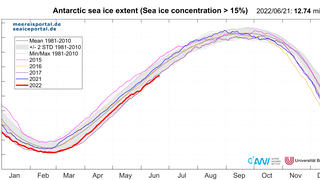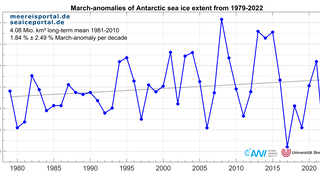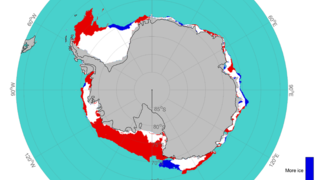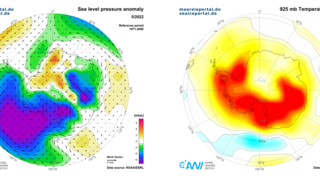In contrast, the pack ice is now steadily growing in the Antarctic. This year, observations of the sea-ice extent development in both hemispheres reveal a trend clearly below the long-term average. The sea-ice extent’s further development in both hemispheres depends on a number of factors and can’t yet be predicted for the remainder of the year.
Development of the sea-ice extent in the Arctic in spring 2022
After the maximum sea-ice extent in the Arctic (14.68 million km²) was reached on 25 February 2022, the extent’s development in the remainder of February was at a level below the long-term average for 1981 – 2010. The month of March was characterised by a low seasonal sea-ice extent, at the lower edge of two standard deviations from the long-term average. In fact, short-term lows were reached on 17 and 23 March that weren’t dropped below until the beginning of the melting process on 12 April. In comparison to the previous year, there was roughly 292,000 km² more ice on the Arctic Ocean in May (Fig. 2), which, particularly in the Greenland, Barents and Labrador Seas, produced sea-ice margins extending to the south.
Despite the below-average sea-ice extent, the months April and May were only 14th and 15th in the long-term on the list of the monthly averages (Fig. 3). The declining trend in sea-ice extent in the spring months March to May is quite similar and amounts to average loss of 2.6 % per decade. Sea-ice loss only progressively increases once summer begins, reaching its maximum in the long-term trend in September, at ca. 12.4 % per decade.
In spring, air temperatures at 925 hPa pressure altitude were roughly 2° C above the long-term average over nearly the entire Arctic Ocean (Fig. 4, right ). In March (Fig. 4, left) an anomaly of up to 6° C formed over the entire Central Arctic to East Siberia, weakening slightly in April (Fig. 4, centre). In May, temperature anomalies in the Central Arctic produced values of ca. 2° C above the long-term average, while the most intensive warming could be seen in western Russia and eastern Siberia, where temperatures were up to 6° C above the long-term average. In contrast, colder temperatures ranging from -1° to -4° C below the long-term average were dominant over Europe, Greenland, Canada and Siberia.
Antarctic shows comparatively low seasonal sea-ice extent
After having reached an absolute low (in the 43-year history of continuous satellite observation) extent in February 2022, sea-ice growth was quite reserved in March 2022 (Fig. 5), an event that should be viewed against the backdrop of multiple low-extent events since 2014. For nearly the entire month, the sea-ice extent hovered near the lower edge of two standard deviations from the long-term average for 1981 – 2010. At 3.1 million km², the sea-ice extent was the second-lowest in the long-term trend, which it undershot by 24% (Fig. 6). The region s with the most substantial ice loss in comparison to the period Region 2003 – 2014 were the Ross Sea and the northwest Weddell Sea (Fig. 7).
Although sea-ice growth in the Antarctic climbed considerably, at an average of 113,600 km² in April 2022 and 93,200 km² in May 2022, it remained below the long-term average. As such, the two months came in at sixth and eighth place on the list of the lowest monthly averages. In the last third of May, ice growth declined again, and has since remained near the lower edge of two standard deviations from the long-term average. Especially in the Ross Sea and Amundsen Basin, an anomalous low-pressure system with uncharacteristically powerful winds developed, transporting warm air masses from the north and northeast over the Bellinghausen and Amundsen Seas to the Antarctic coastal regions, where they produced unusually high air temperatures (more than 6° C above the long-term average) and served to inhibit ice growth (Fig.8).
For both polar regions, now begins the exciting time in which melting / growth sets in and the stage is set for the next seasonal highlight in September. For the Antarctic, it remains to be seen whether or not the currently low sea-ice extent will produce a trend similar to that in the record year 2017.
Contact
Dr. Klaus Grosfeld
Dr. Renate Treffeisen
infoprotect me ?!meereisportalprotect me ?!.de
Graphics
